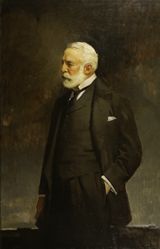 |
||||||||
| Portrait of Henry Clay Frick by John Christen Johansen | ||||||||
 © The Frick Collection, New York |
Henry Clay Frick (1849-1919) -shown here in a posthumous portrait commissioned in 1943 -was one of the most important American collectors to benefit from the 1882 Hamilton Palace sale. Frick became a major collector after the death of his daughter Martha in 1891, and built up a magnificent collection of Old Master paintings, French furniture, and decorative art. In 1915 he was able to secure many items from the estate of the famous American financier J Pierpont Morgan. His 'star buys' were the superb secretaire and commode (chest of drawers) which Jean-Henri Riesener had made for Queen Marie-Antoinette of France in the 1780s and remodelled in 1790-91. Both pieces had been acquired by the 10th Duke of Hamilton. They were bought by two different dealers at the 1882 Hamilton Palace sale, but were reunited and sold by Sir Joseph Duveen to Morgan in 1899. Frick had made his fortune from a monopoly on the production of good quality coke (carbon fuel produced by distillation of coal) in the Pittsburgh region and, in partnership with Andrew Carnegie, developing and running steel mills. A bitter dispute between the two men was settled in 1900, when Frick received over $30 million in bonds and securities, but lost control of the H C Frick Coke Company and the Carnegie Steel Company. He subsequently invested in railways and was worth nearly $200 million at his death in December 1919. |
|||||||
|
|
|
|
|
|
|
|
|
|